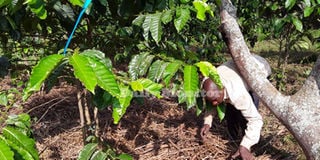Prime
What you need to know about shade systems for a coffee farm

A farmer applies mulch to his coffee garden. Mulching prevents water loss in a coffee plantation.
PHOTO/GEORGE KATONGOLE.
The changing climatic patterns require farmers to practice climate-smart agriculture in order to improve farm productivity and profitability. Planting trees is one way to mitigate the effects of climate change in farming.
According to experts at the Uganda Coffee Development Authority (UCDA), trees help improve plant nutrition, soil moisture, thus mitigating some of the effects of climate-change. They also argue that trees are associated with better cup profiles as they allow the coffee to ripen slower. “Trees reduce soil erosion and help soil retain moisture. Fallen tree leaves prevent soil from losing too much moisture, as well as decaying leaves, that fall onto the ground, turn into nutrients for tree growth,” explains Dr Florence Akwatulira, an agro forester at the National Coffee Research Institute (NaCORI), Mukono.
Benefits
Dr Akwatulira explains that tree canopies provide shade thus mitigating against excessive temperatures and heat stress that are responsible for flower and fruit abortion.
Deep-rooted shade trees recover soil nutrients from deeper soil horizons and transport them to their leaves. When the leaves fall and rot, they provide organic matter or manure which is released to the coffee plantation. This organic matter improves the soil texture and water retention.
Besides, deep rooted trees do not compete with the coffee for water and other nutrients. Dr Akwatulira adds that, shade trees of the leguminous species capture nitrogen from the atmosphere and convert it into nitrates which are used by the coffee for numerous purposes.
Shade trees also act as windbreakers to protect the coffee trees from excessive and destructive winds and some even repel dangerous pests found in the environment. Some shade trees are a source of foliage for domestic animals and at the same time an important source of firewood in rural households when they are pruned to regulate shade.
Shade tree systems
Not all shade trees are the same. There are three shade types used in Uganda and across the world including; agroforestry, intercropping, and leguminous.
Agroforestry
Agroforestry shading is not only useful because it provides shade but because it provides coffee farmers with additional income in the long term. Dr Akwatulira says agroforestry shading is achieved with deep-rooted trees that will produce high valuable wood for sale. However, since the main purpose is to maintain coffee farming, the trees should be spaced out, typically 20m between each tree.
Dr Akwatulira says this system of shading is a low-maintenance system that does not require additional input yet it is a long-term investment. She says it maintains soil structure and provides habitats for birds and other animals.
For about four years now, researchers at NaCORI have identified and recommended shade trees for each of the six coffee-growing sub-regions in Uganda. Tree species such as Albizia coriaria (mugavu) and Ficus natalensis (mutuba), Gliricidia sepium are common among communities. NaCORI multiplies the seedlings of some of these recommended tree species at their Mukono based research station, along the Mukono-Katosi Road.
Dr Akwatulira adds that farmers can optimise the benefits of tree shade by:
• Pruning shade trees to maintain optimal shade intensity at 40-50 per cent;
• Removing excessive suckers from shade and coffee trees;
• Clean weeding the fields and;
• Trimming off and burning infested materials on shade and coffee trees.
Inter-cropping
Coffee can be inter-cropped with shade trees to provide regular revenue. Such trees that can provide nuts and fruit for sale include orange, mandarin, and macadamia nut trees.
Legumes
Since many farmers in Uganda rarely use fertilisers in their coffee farms, leguminous shade trees can be a natural alternative as they can fix nutrients to the soil, especially nitrogen. Recommended spacing should be 10-15 metres apart but specific needs can be addressed with local agronomists.
Trees to avoid
However, Dr Akwatulira advises farmers to be mindful of the choice of tree species they use when intercropping with other crops, noting that some trees can cause soil exhaustion and compete for nutrients, moisture, space and light with other crops. She adds that some tree species promote incidences of pests and diseases, which then affects the quality of the crops.
Sometimes, tree branches fall and destroy other crops in the garden.
According to Dr Akwatulira, tree species with the following traits need to be avoided:
• Trees that are alternate hosts to the Black Coffee Twig Borer for example avocado and Albizia chinensis.
• Hardwood trees that attract pit sawyers such as Grevillea Robusta and Maesopsis emimii or musizi.
• Trees that take very long to grow such as Milicia excelsa or muvule.
• Trees that can only provide conical shaped shade such as eucalyptus and jack fruit trees.
• Trees that have leaves that take very long to decompose.
• Trees that produce thorns as these are very difficult to tame such as Erythrina abyssinica or Ejjirikiti.
• Poisonous trees such as Euphorbia ingens.
Mulching.
Apart from planting trees as a climate-smart practice in coffee production, farmers can also mulch their gardens and dig trenches to conserve moisture in the soil.
According to Dr Alice Nambuya, an agro-forestry scientist at NaCORI, mulch can improve crop production by enhancing soil quality through conserving soil moisture and reducing weed growth.
‘‘When mulch decomposes, it provides organic matter to the soil, which improves its fertility,’’ she adds.
Most widely used materials for mulching are grass, banana trash, coffee pulp and coffee husks, maize stover, sorghum straw and other crop residues.




